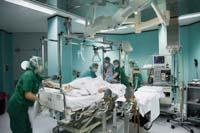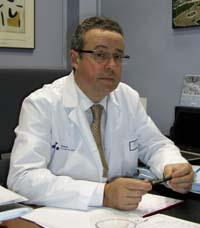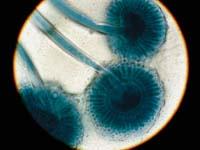Fighting hospital infections

Also in the Autonomous Community of the Basque Country, little by little, working groups on infections and preventive medicine were organized. Measures were taken to reduce urinary tract infections and strict aseptic measures were taken to reduce respiratory infections in intensive care units, studying air and water circuits and testing appropriate surgical techniques, among others. All this reduced the number of nosocomial infections.
Take action, essential
To reduce hospital infections there is an infection committee in each hospital. The work of this Commission is to monitor the issue and guide the general policy or regulations. On the other hand, the services of hospital microbiology and preventive medicine carry out the monitoring of all the procedures, of the anti-infectious measures adopted and, of course, of all the microorganisms that are isolated.

These types of commissions establish the procedures and norms of each of the tasks, adopting anti-infectious measures in all areas: where and how to wash hands, the state of the operating rooms, how to work in special care units, etc.
In addition, they establish the policy of use of antibiotics, since it is not possible to use any antibiotic, since microorganisms generate resistance. Finally, a maintenance policy is also established, such as air conditioning or water circulation.
This group of experts monitors the microorganisms that are isolated in hospitals. The reasons are analyzed and found. For example, if there are 20 patients in a high-surveillance unit, a study of the infections that occur in that unit is performed. And if, for example, they see that eight patients are infected with the same microorganism, they take measures: they do more cleaning than normal, see if the antibiotics selected to kill this microorganism are suitable or not, etc. In addition, both nurses and doctors in this unit receive training and advice on universal preventive measures.
They also analyze the state of the facilities: air filtration, water channeling, etc. Among other things, the pipe should be clean. To do this, they hyperchlorine the water or raise the water temperature. If the water temperature rises to about 60 degrees, the microorganisms present in the water die. All these measures, as well as many others, are adopted by groups of infection experts who establish criteria, procedures and standards.
Why?
Yes, measures are taken. In any case, the reflection to be made on a subject of these characteristics is: Why do infections occur in hospitals? Mikel Álvarez, manager of the Cruces Hospital, points out that for several reasons. "On the one hand, keep in mind that the hospitalized population in general is not healthy, that is, it is not in a healthy immune state. And in most cases they are more at risk of getting an infection than others."

"On the other hand, hospitals attack the patient's body, so to speak. For example, if the patient's skin is cut for intervention, the risk of a microorganism taking its nest and becoming infected will be higher. Undoubtedly, hospital equipment, pipe, etc. they also have a lot to say. Finally, another aspect to consider is that of drugs or antibiotics."
Many of the drugs used in hospitals weaken the person's immune system. That is, they weaken the person and, consequently, it is easier to get an infection. In addition, antibiotics cause selection. In fact, antibiotics kill microorganisms and help natural immunity to act against them, but only kill the weaker microorganisms, so to speak, while the rest -- the most powerful -- stay in the body itself. It can be said that the most evil flora survives and that hurts. In fact, this flora develops resistance and often adapts to the drugs or antibiotics used. With one example it is better understood: a few years ago penicillin served for everything and today it serves little because microorganisms have adapted.
Therefore, according to Mikel Álvarez, "antibiotics should be used rationally, because otherwise it is useless because microorganisms have the capacity to develop a defense system."
Infectious sources
The microorganisms that cause nosocomial infections depend on the patient, hospital and geographic environment. Hospital infectious causes are bacteria, fungi, viruses and parasites. In this order, the most infections cause the least.

The most dangerous and perhaps the best known are gram-positive and gram-negative bacteria. Gram-positive bacteria, such as Staphylococcus aureus, are found in the human body. Half of the infections that occur in high-surveillance units are due to gram-positive microorganisms. Pneumonia caused by mechanical breathing and catheter infections are the most common. The gram-negative (Acinetobacter baumannii, Legionella neumophila) can be found both in the human body and in the environment. The species Acinetobacter baumannii is especially related to respiratory and urinary infections and posterior septicemias. Causes pneumonia and other infectious processes in special care rooms. These infections are often caused by respiratory devices and other monitoring systems. It has very effective mechanisms for antibiotic resistance.
As for fungi, they predominate over people who take a lot of antibiotics. The genus Candida, for example, is found in the human mouth and in the digestive tract. Known fungi of the genus Aspergillus are found in the air. They do not live in the human being, but among them. The spores of the Aspergillus mushroom are everywhere, at home, at school, in the hospital... because the air carries them with dust. In hospitals they can become a serious problem due to increased sensitivity to infections.

The ventilation of operating rooms, for example, is very controlled and numerous studies have been carried out on the relationship between the operation of ventilation systems of operating rooms and acquired aspergillosis and other infectious diseases. However, there are many and varied fungi and, when they reach the right time, they are able to cause infection.
Viruses, in general, cause infections in people who have been transplanted into the hospital. This is because the immune system of these patients is weakened to prevent transplant recusal, resulting in infections with various viruses. They appear or predominate for mechanical or immune reasons. Parasite infections are minor.
In hospitals, most infections are not transmitted by air, although it is often believed to be the same. The transmission of microorganisms from one patient to another is done mainly by contact. On the other hand, many hospital diseases are endogenous. That is, each one has a series of microorganisms that, in case the immunity decreases, prevails. Therefore, it is not necessary to transmit it. It can spread with food or water. For example, Legionella bacteria, which inhabits the water, by breathing unconsciously along with water vapor, in some cases infections occur.
High risk areas
Four main types of infections can be distinguished: urinary, respiratory, surgical, and asepsis or blood.

At one time the urinary tract was widespread, according to Mikel Alvarez. Today, in most cases, surgical infections occur, which occur in operative wounds. In 2006, the number of hospital infections in Cruces Hospital was 7.63%, of which approximately 2% were surgical.
As for respiratory infections, according to 2006 data, this type of infection represented 1.8% of cases. Most of them occur in large surveillance units. In fact, patients in these rooms are in critical condition and should normally be connected to a respiratory system.
The number of infections is not the same in all parts of the body and the risk is not the same in all hospital units. Very few infections occur in the units in which mothers come to have children. In these cases people are healthy. Even if it seems to be a lie, the risk in high-surveillance units is higher. In these units, in general, one in four people is infected.

They are the units of greater cleaning and special surveillance, as the name suggests. These units take stricter measures. Normally the air is filtered to ensure that the possible microorganisms present in the air have not crossed the filter. Just in case, the sick are in different rooms, more separated from each other. However, due to the poor condition of patients, it is in this unit that most infections occur. In the words of Mikel Alvarez "it is a normal process, they will be cured."
It is clear that no one will go to the hospital, but sometimes you have to go. However, after reading, do not think that this is a worrying situation. In fact, infections only occur if they are given the opportunity and work is being done to prevent options in hospitals, reducing the pathways of infection. In addition, statistical data show that hospital infections are declining year after year.







